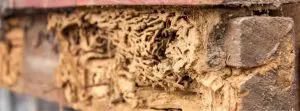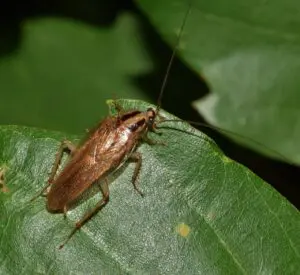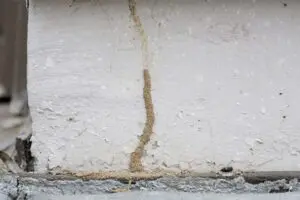

Are you interested in learning more about cockroaches? Well, with this guide you can quickly become a cockroach expert. Here is all you need to know about these tiny pests.
Have a specific question? Jump to the answer:
What do cockroaches look like?
What attracts cockroaches and where can I find them?
Why are cockroaches dangerous for humans?
Could cockroaches really survive a nuclear apocalypse?
Will cockroaches evolve to eat humans?
Cockroach Infestation Prevention
Do I have a cockroach infestation?
What’s the best way to prevent a cockroach infestation?
How do I get rid of cockroaches?
Cockroach Basics
What is a cockroach?
Cockroaches are members of the Blattodea order and are part of a paraphyletic group that excludes termites. With a staggering count of over 4,600 species of cockroaches worldwide, the United States is home to 55 of them. While some cockroaches are deemed pests, others play beneficial roles in their natural habitats.
What do cockroaches look like?
One thing is for sure, all cockroaches, no matter their species, look unnerving. Most of these insects have flat, oval-shaped bodies that are typically brown or dark brown, although coloration can vary. They have 6 long, spiny, and spindly legs that allow them to quickly scuttle from one location to the next. They also possess 2 long antennae that produce from their heads, which they use to sense their environment. These antennae are usually segmented and can be as long, or sometimes even longer, than their bodies.
The size of cockroaches can range from small to large, with lengths varying from between half an inch to a couple of inches. Some cockroach species have 2 pairs of wings, with the front pair being longer and more developed than the back. However, not all species are capable of sustained flight. Overall, cockroaches are hardy creatures that can tolerate a wide range of environments.
Types of Cockroaches in America
In American homes, six primary types of cockroaches commonly emerge:
- The American cockroach (Periplaneta americana)
The American cockroach, a prevalent species worldwide, is known for its invasive nature in both residential and commercial settings. Among pest cockroaches, it stands out as one of the largest in size. While equipped with fully developed wings, American cockroaches primarily rely on flight for short distances, preferring other means of transportation for longer journeys. Their attraction to fermented food makes them frequently encountered in sizable commercial structures where food is stored. These pests not only gravitate towards food sources as adults but also deposit their egg sacs in cracks and crevices near these areas. American cockroaches are commonly found in a range of establishments, including restaurants, food processing plants, and hospitals, as they instinctively follow the available food supply.
- Brown-banded cockroach (Supella longipalpa)
In the early 1900s, Brown-banded cockroaches made their way to the United States and have since spread throughout the country, showing a preference for warmer regions with temperatures exceeding 80℉. These cockroaches can be identified by the distinctive brown bands that stretch across their wings and a notable "liberty bell" shape on their pronotal shield, near the head. They have the potential to carry disease-causing bacteria on their legs and bodies, which they can deposit throughout homes or businesses as they move around.
- German cockroach (Blattella germanica)
The German cockroach holds the title of being the most prevalent cockroach in the United States. It has a strong affinity for hiding in kitchens and bathrooms because it is drawn to the warmth and humidity these spaces offer. In such environments, German cockroaches exhibit accelerated development which creepily accelerates the pace of an infestation. Throughout her lifetime, each female German Cockroach can produce an average of five egg sacs, each containing 30-40 eggs. Although German cockroaches possess wings, they generally prefer scurrying over flying as their primary mode of movement. When dealing with an infestation, one might discover droppings or fecal staining in the areas where they hide. In cases of a substantial infestation, you may detect a mild musty odor.
- Oriental cockroach (Blatta orientalis)
The Oriental cockroach is renowned for its exceptional resilience, capable of enduring prolonged periods of freezing weather. Interestingly, unlike other cockroach species, these sturdy creepers are attracted to cool and damp environments, prompting their migration into basements and crawl spaces during extremely cold temperatures. These cockroaches primarily dwell outdoors, often found amidst garbage and debris. Due to their preference for feeding on unclean matter, they have an increased likelihood of transmitting bacteria compared to other species. They are known carriers of organisms that can cause gastroenteritis, a condition characterized by inflammation of the stomach and intestines.
- Smokybrown cockroach (Periplaneta fuliginosa)
The Smokybrown cockroach is predominantly found in outdoor habitats throughout the southern United States. The humid environment in this region proves ideal for these cockroaches as they are more prone to moisture loss compared to other species. The humidity helps prevent them from drying out. To minimize further moisture loss, they tend to limit their movements unless driven by the need for food. While the Smokybrown cockroach seldom resorts to biting unless compelled by extreme circumstances, it is worth noting that body parts and feces left behind by these cockroaches can act as significant allergens, similar to the German cockroach. Setting it apart from many other cockroach counterparts, the Smokybrown cockroach is an adept flyer. With wings extending beyond its abdomen, it exhibits frequent flight, particularly towards light sources.
- Field cockroach
The field cockroach, also known as the vaga cockroach, is a small species of cockroach believed to have been introduced to the United States from southwest Asia. While resembling German cockroaches in appearance, they can be identified by the blackish-brown area on their faces, extending from the mouthparts to the area between their eyes. Females of this species can live for over 200 days, producing between 200 to 300 offspring or up to six generations annually. Unlike other cockroaches, field cockroaches can fly and are not repelled by light, making them active during the day and easily spotted.
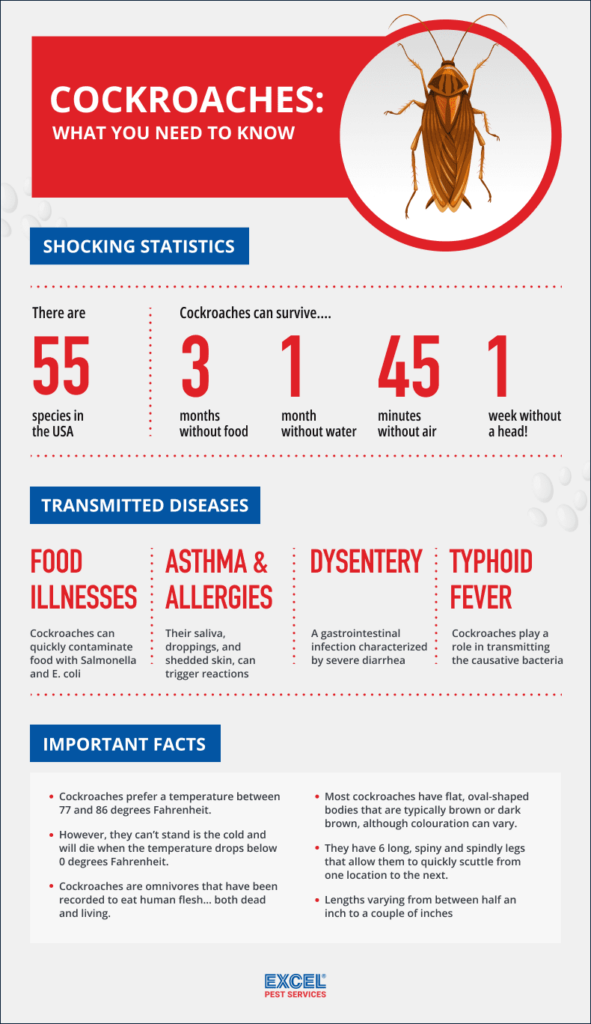
Cockroaches in New Jersey
Cockroaches are common pests in New Jersey due to factors such as food availability, moisture and warmth, and will often seek shelter in homes and buildings across the region. The main types of cockroaches found in the state include German cockroaches, which are usually found in kitchens and bathrooms. American cockroaches, one of the largest species, are commonly found in New Jersey and are usually spotted in dark, damp areas such as basements and sewer systems. Oriental cockroaches, also known as "water bugs," are common in the Garden State and prefer cool and damp environments and are often found in basements and crawl spaces.
Cockroaches in Florida
Cockroaches are common pests in Florida due to the state's warm and humid climate. Among the main types of cockroaches found in Florida is the American cockroach (Periplaneta americana), which is both prevalent and large in size. The warm and moist environment in Florida provides an ideal habitat for these cockroaches to thrive. They can often be found in various locations such as basements, sewers, and other damp areas. Another common species in Florida is the German cockroach (Blattella germanica), known for its rapid reproduction and preference for areas with readily available food and water sources. The Oriental cockroach (Blatta orientalis) is also found in Florida, particularly in cooler environments like basements and crawl spaces while the smokybrown cockroach (Periplaneta fuliginosa) is more common in Florida than in other regions.
What attracts cockroaches?
Cockroaches will make their way to an area to fulfill their need for food, water and shelter. What will gain cockroaches attention is readily available food sources, and they will scurry their way to any location that offers this basic need. These creepy crawlies are particularly drawn to crumbs, grease, food residues, and any uncovered or poorly stored food and this is why you will find cockroaches in home kitchens, hotels and restaurants.
Moisture and water also play a significant role in attracting these sturdy insects. Cockroaches gravitate toward environments with plenty of moisture, such as leaky pipes, dripping faucets, standing water, and areas with high humidity. Bathrooms, kitchens, and basements are common places where cockroaches will find the moisture they need to survive.
Cockroaches also seek warmth and shelter which is why they are inclined to hide in warm and secluded areas where they can nest and reproduce. Cracks, crevices, wall voids, and cluttered spaces provide them with the ideal shelter they desire.
Cockroaches have also been known to be attracted by various odors and scents. Strong smells from garbage, rotting organic matter, dirty dishes, and unsanitary conditions can quickly entice them to infest a space.
In order to adequately prevent cockroach infestations, it is important to address these attractions. This includes properly storing food, maintaining cleanliness, fixing leaks, reducing humidity, sealing entry points, decluttering, and promoting good hygiene practices throughout living spaces. By eliminating or simply minimizing these attractants, you can deter cockroaches from invading your space.
Why are cockroaches dangerous for humans?
You may want to strap in for this one! Cockroaches can pose risks to human health as they are known to carry and spread various diseases. While not all cockroaches are direct carriers of diseases, they can still contribute to the transmission of a variety of dangerous pathogens.
Below, we take a look at some diseases associated with these pesky pests:
- Foodborne illnesses: Cockroaches can quickly contaminate food and food preparation surfaces with disease-causing bacteria including Salmonella and E. coli. When humans consume this contaminated food or simply come into contact with these contaminated surfaces, we can develop food poisoning or significant gastrointestinal infections.
- Asthma and allergies: Allergens from cockroaches, such as their saliva, droppings, and shedded skin, can trigger allergic reactions in sensitive individuals. It is important to note that in some cases prolonged exposure to these allergens can lead to the development or worsening of allergies and asthma symptoms. These symptoms include coughing, wheezing, sneezing, and skin rashes.
- Dysentery: The 6 legged creatures can be carriers of the bacteria that cause the dreaded dysentery. This is a gastrointestinal infection characterized by severe diarrhea. When cockroaches contaminate food or food preparation areas with these bacteria, it can result in the spread of dysentery to humans - keep those kitchens clean!
- Typhoid fever: In areas where typhoid fever is prevalent, cockroaches can play a role in transmitting the causative bacteria, Salmonella Typhi. Cockroaches are able to pick up the bacteria from sewage or contaminated environments and then transfer them to food or surfaces, potentially leading to the spread of this serious illness.
It's important to note that the risk of disease transmission from cockroaches depends on a variety of factors, including the specific species of cockroach, hygiene practices, and overall sanitary conditions. In order to minimize the potential health risks associated with cockroaches, it is crucial to maintain cleanliness, eliminate their presence, and take appropriate pest control measures.
Freaky cockroach facts
What can cockroaches survive?
Cockroaches can survive up to three months without food, a month without water, 45 minutes without air and a week without their head! Because of this, it’s no surprise that cockroaches were able to survive the mass extinction event which killed of dinosaurs and even survive when taken to space!
However, just like us, cockroaches prefer a temperature between 77 and 86 degrees Farenheit and one thing that cockroaches can’t stand is the cold and will die when the temperature drops below 0 degrees Fahrenheit.
Could cockroaches really survive a nuclear apocolypse?
It’s a popular trope that cockroaches will be some of the sole survivors of a nuclear war. Cockroaches aren’t as indestructable as popular myths might lead us to believe, but they can withstand 15 times the level of radiation that we can – meaning that there is some truth to the prediction.
But there is a caveat to cockroaches impressive ability to withstand radiation. When cockroaches molt, they become far more exposed and vulnerable to radiation and their cells are far more likely to become damaged.
Will cockroaches evolve to eat humans?
Because they are already so resilient and efficient, cockroaches haven’t evolved for 300 million years, so the likelihood of them evolving anytime soon to become ravenous human killers is small. However, cockroaches are omnivores that have been recorded to eat human flesh… both dead and living. Cockroaches are most likely to snack on your fingernails, eyelashes, feet and hands.
Considering this, the worst case scenario is that cockroaches might evolve to become intelligent enough to hunt in packs - or venomous enough to kill with their bite, and feast on the corpse after.
Cockroach Infestation and Prevention
Do I have a cockroach infestation?
Cockroaches are resilient pests and know how to hide from humans. This is why homeowners and business owners often don’t recognise a cockroach problem until it has developed into a serious cockroach infestation. This is why it's vital to take preventative measures, keep an eye out for these creatures and take immediate action if you believe you have a problem.
But, how do you know if you are dealing with a cockroach infestation? There are certain signs to look for, and some are easier to figure out than others. Let’s take a look.
- Visual sightings: Cockroaches are nocturnal creatures, so if you spot them during the day, especially in areas such as kitchens, bathrooms, or dark corners, it could indicate an infestation.
- Small droppings: Keep an eye out for droppings! Cockroach droppings resemble small, dark specks or coffee grounds. You may find them in areas where cockroaches are active, such as along baseboards, in cabinets, or behind appliances.
- Egg capsules: Cockroach egg capsules, also known as oothecae, are usually brown or tan and are shaped like elongated capsules. Finding these egg cases in hidden areas such as cabinets and shelving, indicates an infestation.
- Foul odor: A persistent, musty odor can be a sign of a very large cockroach infestation. Cockroaches produce pheromones that contribute to this unpleasant smell.
- Shed skins: As cockroaches grow, they shed their skins multiple times. Discovering these discarded exoskeletons in your home suggests the presence of cockroaches.
- Damage to materials: Cockroaches have been known to cause damage to materials like paper, cardboard, and fabrics. Look for signs of chewed edges, holes, or irregular damage.
- Grease marks: These sturdy insects leave behind greasy smears on surfaces as they navigate through your home. Look for these smudges along walls, baseboards, or other areas they frequent.
If you notice one or several of these indicators, it's advisable to contact a professional pest control service to assess and address the cockroach infestation effectively.
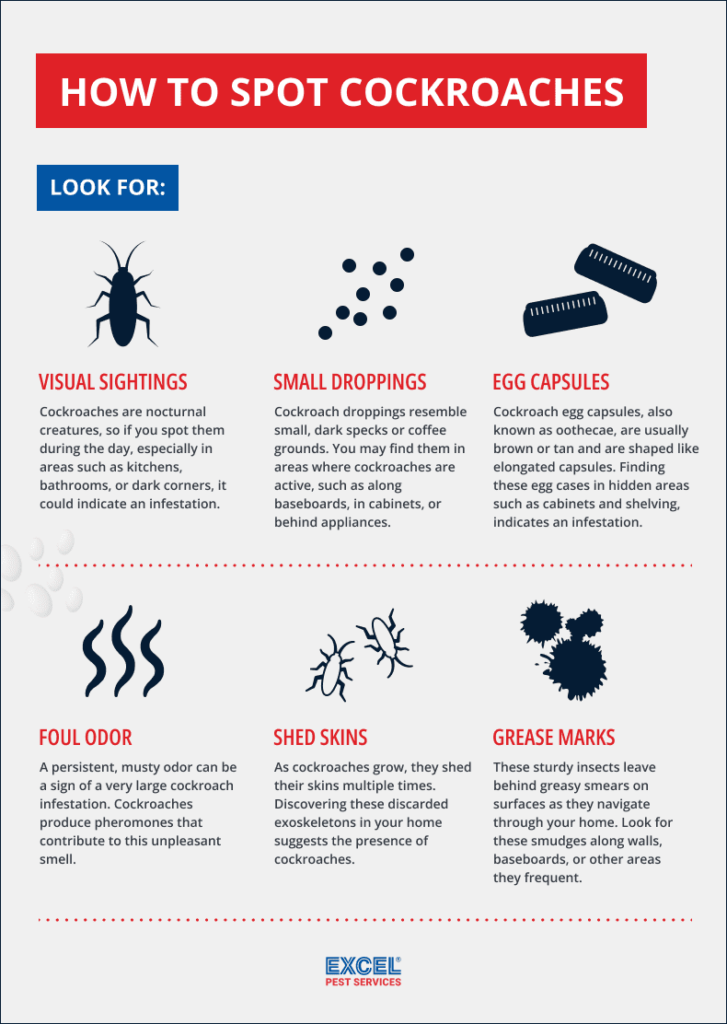
What’s the best way to prevent a cockroach infestation?
Prevention is always better than cure and it is important we all protect our space from pesky cockroach infestations. Preventing a cockroach infestation involves implementing proactive measures to make your home or business less attractive to these pests.
Below are some effective cockroach infestation prevention tips:
- Maintain cleanliness: Regularly clean your home or business space, paying close attention to the kitchen, dining areas, and bathrooms. Clean up food and drink spills promptly, wipe down surfaces, and sweep/vacuum floors regularly.
- Eliminate food sources: As cockroaches are drawn to readily available food, make sure to store food in sealed containers, clean up crumbs, and keep trash bins tightly sealed and also avoid leaving pet food out overnight.
- Seal possible entry points: Keep the creepy crawlies out by sealing any cracks, gaps, and openings around windows, doors, pipes, and utility lines to prevent them from making a home on your property.
- Reduce moisture: These 6 legged pests are drawn to warmth and moisture so make sure to fix leaky pipes, faucets, and drains. Also ensure proper ventilation in damp areas like bathrooms and basements.
- Declutter your space: Time to get cleaning and organizing! Remove clutter, especially in storage areas, as cockroaches find these spaces attractive for nesting.
- Outdoor maintenance: Keep the exterior of your home tidy by trimming vegetation away from the house. Remove debris and leaf piles, as they provide hiding places for cockroaches.
- Professional pest control: Working with a reputable pest control company is crucial in preventing and addressing cockroach infestations. Pest control experts have the knowledge, experience, and resources to identify entry points, implement effective treatments, and provide ongoing monitoring to keep your home free from cockroaches.
By following these preventive measures and partnering with a professional pest control company, you can significantly reduce the risk of a cockroach infestation and ensure a pest-free living environment for you and your family.
How do I get rid of cockroaches?
It is important to address a cockroach infestation as soon as possible. If you think you have a problem, get in touch with Excel Termite & Pest Control to see how we can help. As one of the leaders of Florida and New Jersey pest control, we know a thing or two about how to handle pests.
You’ll ultimately save money if you take steps to handle the problem rather than waiting until it is out of control. If you know what to look for, you can get service started right away and take back control of your house!
If you are concerned that there is a cockroach problem in or around your home or business, don't hesitate to contact Excel Pest Control for comprehensive residential pest control and commercial pest control services. Our experienced team is here to address your specific pest control needs and ensure a pest-free environment in both residential and commercial spaces. Get in touch with us today to take proactive steps in pest control.




